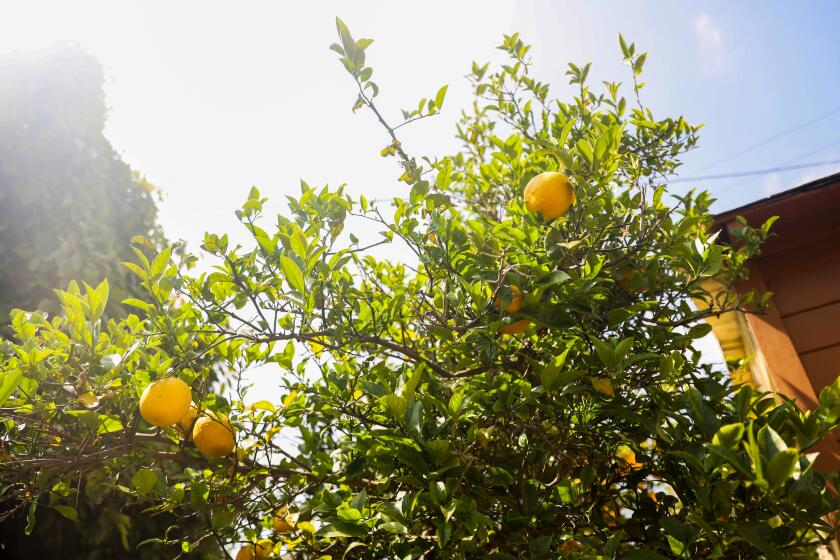Poisoned trees gave a wealthy couple in Maine a killer ocean view. Residents wonder, at what cost?

- Share via
CAMDEN, Maine — Suspicious deaths in an idyllic seaside community and detective work that points to poison sound like themes from a classic murder mystery. But the victims in this Maine whodunnit were trees that stood in the way of a wealthy family’s oceanfront view, allegedly felled by well-heeled killers who, while ostracized and publicly shamed, remain free.
Wealth and hubris fuel the tale of a politically connected Missouri couple who allegedly poisoned their neighbor’s trees to secure their million-dollar view of Camden Harbor. The incident that was unearthed by the victim herself — the philanthropic wife of L.L. Bean’s late president — has united local residents in outrage.
To make matters worse, the herbicide used to poison the trees leached into a neighboring park and the town’s only public seaside beach. The state attorney general is now investigating.
“Anybody dumb enough to poison trees right next to the ocean should be prosecuted, as far as I’m concerned,” said Paul Hodgson, echoing the view of many exasperated residents in Camden, a community of 5,000 nestled at the foot of mountains that sweep upward from the Atlantic Ocean and overlook a harbor filled with lobster boats, yachts and schooners.
Species like the Coastal live oak in West Hills and the Moreton bay fig in Palms tell the story of Los Angeles and what the land was like even before the city was here.
If this were a made-for-TV drama, the story set against the backdrop of this quaint village would have it all: wealthy out-of-state villains, a sleuthing member of the venerable L.L. Bean family, and the same powerful chemical used to avenge Alabama’s loss on the football field to archrival Auburn.
Amelia Bond, former CEO of the St. Louis Foundation, which oversees charitable funds with more than $500 million in assets, brought the herbicide from Missouri in 2021 and applied it near oak trees on the waterfront property of Lisa Gorman, wife of the late Leon Gorman, L.L. Bean’s president and grandson of L.L. himself, according to a pair of consent agreements with the town and the state pesticide board.
Bond’s husband, Arthur Bond III, is an architect and the nephew of former U.S. Sen. Kit Bond. Their summer home, owned by a trust, is situated directly behind Gorman’s home, farther up the hill.
When the trees and other vegetation began dying, Amelia Bond told Gorman in June 2022 that the tree didn’t look good and offered to share the cost of removing them, Gorman’s lawyer wrote in a document.
Why does Southern California have so many residential fruit trees? Credit the weather, developers, even the Gold Rush. Plus: a list of plant-related June events.
Instead, Gorman had the trees tested. Soon, lawyers were involved.
More than $1.7 million in fines and settlements later, the trees are now gone and the harbor view from the Bonds’ home is improved. But the chemical has leached into a neighboring park and beach, leaving the Bonds potentially on the hook for further monitoring and remediation, and Maine’s attorney general has agreed to further investigate the incident.
The herbicide — Tebuthiuron — was the same one used in 2010 by an angry Alabama football fan to kill the Toomer’s Corner oak trees at Auburn University, following a Crimson Tide loss to their archrival. The incident earned jail time for Harvey Updyke, who acknowledged poisoning the trees.
Tebuthiuron contaminates soil and doesn’t break down, so it continues to kill plants. At Auburn University, it took the removal of about 1,780 tons (1,615 metric tons) of contaminated material to achieve negligible levels of the chemical in the soil.
Short of removing the soil, the only other solution is dilution — waiting for nature to thin out the concentration of the herbicide to safe levels for plants. It could take six months to two years for it to be diluted enough to no longer endanger the plants, said Scott McElroy, an Auburn professor specializing in weed science and herbicide chemistry.
Trees can spark memories, mark time and give us a comforting place to return to. What trees do you love?
Back in Maine, Tom Hedstrom, chair of the Select Board, said his job typically requires finding consensus on how to proceed with delicate political matters. But this time there is no need because residents are united in their anger.
Hedstrom said he, too, is appalled by the behavior.
“Wealth and power don’t always go hand in hand with intelligence, education and morals,” he said. “This was atrocious and gross and any other word you want to use to describe abhorrent behavior.”
The Bonds have paid a price for their actions, which they acknowledged in the consent agreements.
They paid $4,500 to resolve Maine Board of Pesticides Control Board violations for unauthorized use of an herbicide that was applied inappropriately and not allowed for residential use, $180,000 to resolve violations with the town and another $30,000 for additional environmental testing, according to documents. They also paid more than $1.5 million to Gorman in a legal settlement, according to a memo from Jeremy Martin, the town’s planning and development director.
The Metropolitan Water District of Southern California is offering residents up to $500 to plant trees and expand the urban canopy.
A lawyer for the Bonds said they have no comment, but they “continue to take the allegations against them seriously. They continue to cooperate with the town of Camden, state of Maine and the Gormans, as they have done over the last two years.”
A lawyer for Gorman declined comment.
Rep. Vicki Doudera (D-Camden) said she intends to address the $4,500 maximum fine that the Maine Board of Pesticide Control was allowed to assess. One of her ideas is a sliding scale that accounts for scope of damage and intent.
“It makes me so livid,” Doudera said. “This situation, the minute I heard about it, I thought, ’Wow! These people are going to get a slap on the wrist.’ That’s just not right.”
On a recent afternoon, no one was home at the Bond residence while people walked their dogs less than 500 feet away on Laite Memorial Beach, where the herbicide that’s lethal to aquatic plants has been detected.
The jacarandas are blooming in all their glory. These maps show where you can find high concentrations of the love-it-or-hate-it tree.
Camden resident Dwight Johnson described as “underhanded” the way Amelia Bond feigned being a good neighbor by offering to share the costs of removing trees that she’d poisoned. Lynn Harrington, another town resident, questioned whether the Bonds could show their faces around town, where they used to be members of the Camden Yacht Club.
Some residents say the episode fits with the well-worn stereotype of wealthy summer residents “from away” — the Maine term for outsiders — running roughshod over full-time residents.
But some residents pushed back against casting summer residents as troublemakers.
Hodgson said Camden is not without its own rule-bending characters in a community where there are plenty of year-round residents who are both wealthy and entitled. He said some residents in the community where the median income is just under $93,000 — high for Maine, the poorest state in New England — have been known to cut down trees, knowing it’s illegal.
“They just pay the fine because they have plenty of money,” Hodgson said. “That’s the town we live in.”
Sharp writes for the Associated Press.
More to Read
Sign up for Essential California
The most important California stories and recommendations in your inbox every morning.
You may occasionally receive promotional content from the Los Angeles Times.















